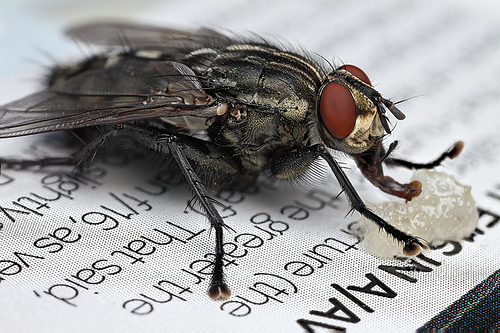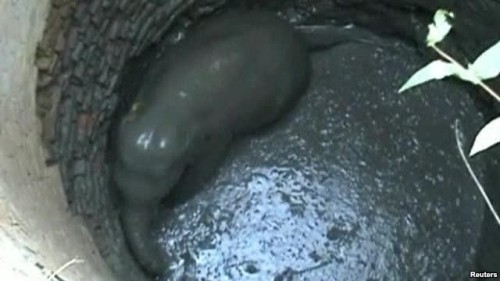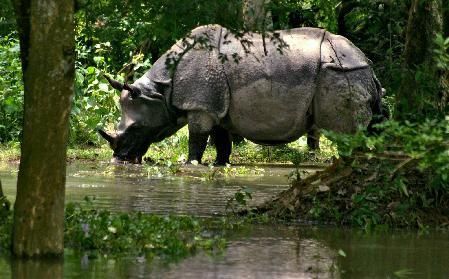It is not easy being a field researcher. Sometimes perched on top of tree branches you are left fighting good and bad weather just to study a tree frog that chooses to reside in the same high rise home. Sometimes crouched on the ground, you study the dung sample of an animal that others would avoid from miles away. Data collection is hard work and though newer technologies like the camera trap have made the job a bit easier for researchers the biggest help in the future may come from tiny insects like flies – the new bio-helpers for field research worldwide!
For researchers, in order to collect data about plants and animals they are studying, spending days, weeks even months in inhospitable conditions is a pre-requisite of their job. But sometimes, despite the dedicated efforts, it is still not possible to observe species that remain hidden and prefer to remain so in human presence.
A fleeting glimpse on a grainy remote camera trap, a decomposed carcass can reveal unknown secrets of a particular species but what about those that do not even present with such indirect clues?
Fly Spy
Now the scientific community may find help from the living world itself, more precisely insects that give definite clue of the presence of a new, undetected or undiscovered species with least bit of field work by the researchers.
According to a new research published in the Journal Molecular Ecology researchers from the Robert Koch Institute in Berlin, Germany, suggest easy-to-catch insects can inform on hidden and vulnerable vertebrates.
The researchers quite accidently made the foray into this new way of observation and data collection.
They were studying how the fatal disease anthrax spreads in Africa but finding it difficult in locating carcasses in the impregnable rainforests. The team turned to the flies for help.
The flesh-eating carrion flies were dissected by the scientists to reveal the presence of the bacteria that showed what they had been eating. It also showed traces of the DNA of the animal which the flies had been feeding on.
Thus by simply DNA analysis of the flies gut food content, researchers could identify the animal they had fed on and thus its presence in the area.
“We were quite surprised that no-one else had this idea but that’s the way it goes with obvious ideas,” Dr Fabian Leendertz, who led the research, tells BBC Nature.
Spotting the Rare Species
Dr. Leendertz says that flies could change the way researchers study forests, habitats and biodiversity and especially help in discovering rare species.
In Madagascar they recorded 13% of the known mammal species present in the guts of just 40 flies. The relatively small sample studied in the Ivory Coast confirmed six of the nine local species of primate. What is more, the rare and endangered antelope Jentink’s duiker could be traced to be present in the area, thanks to the fly that had been feeding on it!
“The most important thing to perform well-targeted conservation actions is first to actually know which mammals are in a given area,” said Dr Leendertz. “In Savannah regions that may be easier because you walk there or fly over in your plane and count the giraffes. But in the rainforest it’s very difficult to see anything and to know [what] is living there.”
Apart from discovering rare or new species, flies could also help in cross-checking present information.
The researcher believes that present data present on most species is either too old or does not give the exact picture of the current population of a particular species.
But the so-called “invertebrate DNA” method could help to update current figures and improve their accuracy.
Data Trackers
It is still to early to say how the flies can revolutionise data collection in the years to come. Also, if the DNA sample collected from their gut may actually give concrete evidence of the animal’s presence in a particular area. The fly could after all have travelled any distance.
But what the research does provide is a brand new tool in the hands of biologists who spends unsurmountable hours and literally pull heaven and earth together to gather information on the living species of the world.
According to International Union for Conservation of Nature (IUCN) around 14% of the 5,400 terrestrial animals listed in the infamous ‘Red list’ of threatened species are put under the tag “Data Deficient”.
In India, most of the botanical and zoological listing of species is either historical data with no modern relevance or too little information to be of any help.
In such cases, the flies may in all possibility be the researcher’s new best friend.
More Related Stories,
Carnivorous Plants Emit Blue Glow to Attract Prey
Kawal: India’s 42nd Tiger Reserve
How Children can Get Close to Nature
Image courtesy Tristram and Lord V via cc/Flickr








2 thoughts on “Finding Rare Species may Soon be a Fly’s Job!”